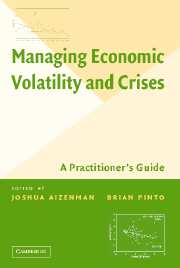Book contents
- Frontmatter
- Contents
- Contributors
- Acknowledgments
- Foreword
- MANAGING ECONOMIC VOLATILITY AND CRISES
- Overview
- PART I WHAT IS VOLATILITY AND WHY DOES IT MATTER?
- 1 Volatility: Definitions and Consequences
- 2 Volatility and Growth
- 3 Volatility, Income Distribution, and Poverty
- PART II COMMODITY PRICES AND VOLATILITY
- PART III FINANCE AND VOLATILITY
- PART IV MANAGING CRISES
- Technical Appendix
- Index
- References
1 - Volatility: Definitions and Consequences
Published online by Cambridge University Press: 25 July 2009
- Frontmatter
- Contents
- Contributors
- Acknowledgments
- Foreword
- MANAGING ECONOMIC VOLATILITY AND CRISES
- Overview
- PART I WHAT IS VOLATILITY AND WHY DOES IT MATTER?
- 1 Volatility: Definitions and Consequences
- 2 Volatility and Growth
- 3 Volatility, Income Distribution, and Poverty
- PART II COMMODITY PRICES AND VOLATILITY
- PART III FINANCE AND VOLATILITY
- PART IV MANAGING CRISES
- Technical Appendix
- Index
- References
Summary
SETTING THE STAGE
Some decades ago, output volatility was perceived mainly as a fleeting business cycle phenomenon of secondary concern for longer-term development objectives. Theoretical advances have since melded short-term and long-term fluctuations into a single framework, while a growing body of research suggests that higher volatility is causally associated with lower growth. Volatility has hence assumed a more central role in the development debate. This chapter introduces some of the themes taken up in more depth in later chapters.
As a background to the discussion, Figures 1.1 through 1.7 illustrate some core linkages for a broad sample of countries. Figure 1.1 plots the volatility of GDP per capita growth (measured as the standard deviation of the growth rate) against the mean growth rate of GDP per capita, revealing the broad negative association that has motivated the increased attention to volatility. Figures 1.2 and 1.3 illustrate the link between output volatility and income inequality: higher growth volatility goes hand in hand with a higher Gini coefficient and a lower income share of the lowest quintile of the population.
Figure 1.4 differentiates the link between growth volatility and growth by income group. While, as Figure 1.1 revealed, the correlation is negative for the full sample, splitting the sample by income groups reveals three distinct relationships. For the group of low-income countries, growth volatility and average growth are negatively associated.
- Type
- Chapter
- Information
- Managing Economic Volatility and CrisesA Practitioner's Guide, pp. 45 - 64Publisher: Cambridge University PressPrint publication year: 2005
References
- 19
- Cited by



